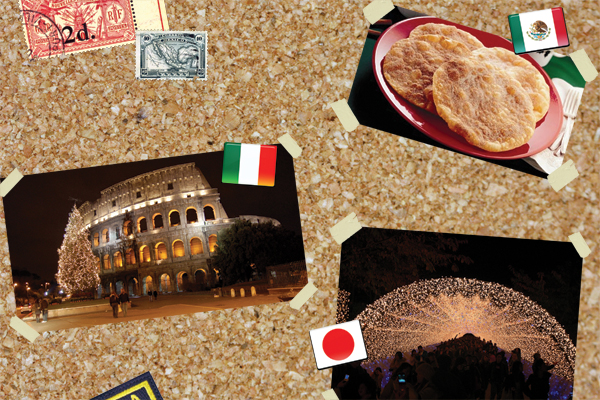A look into the holiday traditions of other countries
Photo illustration by Tina Wallace
For most, Christmas Day symbolizes family reunion, tradition, and a time of rest. In Canada, especially Ottawa, we see lights and holly strung throughout the ByWard Market, hear Christmas tunes on almost every radio station, and often see carollers throughout the streets as Christmas Day approaches. In other parts of the world, however, Christmastime is celebrated very differently, and every country and culture has their own traditions.
Italy
In Rome during the Chrsitmas season, you can visit the annual “100 Presepi” exhibition at the Piazza del Popolo square to see a selection of traditional Nativity scenes recreating the birth of Jesus.
The Myth of Le Befana is told to children in Italy in place of the North American Santa Claus. Befana is said to be an old woman who drops candy or coal down children’s chimneys on her search for baby Jesus, and though her actions mirror Santa’s, her appearance is a little less friendly—Befana is a wrinkly old witch.
Japan
Though the Italians mostly celebrate Christmas in the Catholic tradition, the Japanese stray far from the original religious significance of Christmas and celebrate it as if it were simply a time of fun for family.
In December 2010, New York Times blogger Francisco Toro wrote that Japan “may be less than 1 per cent Christian, but it’s 100 per cent Christmas,” highlighting the importance of Christmas to a non-Christian population.
Around the country, carols are blasted on loud speakers in the streets and though older Christmas traditions, like distributing oseibos—formal packages of food or drink sent to colleagues, bosses, and in-laws as gestures of thanks and a fruitful relationship—are still upheld, Christmas is becoming more and more Westernized.
Mexico
An unusual tradition in Oaxaca, Mexico is called la Noche de Rábanos, or Night of the Radishes. On the evening of Dec. 23, farmers present extraordinary sculptures of nativity scenes, robed kings, and musicians, all carved out of—you guessed it—giant radishes.
Another holiday tradition of the people in Oaxaca is when they break plates to celebrate the New Year. People buy crispy buñuelos, topped with sugar or syrup, from stands and smash the ceramic plates to the ground to signify the end of the old year.
This is a great one to try at home with some dollar store ceramic ware. You know your News Year’s Eve festivities will most likely result in broken glass anyway. Why not ring in the New Year with a bang and smash some plates at midnight?





